Chem 301 chemistry 301 - Study guides, Class notes & Summaries
Looking for the best study guides, study notes and summaries about Chem 301 chemistry 301? On this page you'll find 21 study documents about Chem 301 chemistry 301.
Page 2 out of 21 results
Sort by
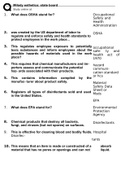
-
Milady Esthetics State Board Test All
- Exam (elaborations) • 62 pages • 2023
-
- $14.49
- + learn more
1. What does OSHA stand for? Occupational Safety and Health Administration 2. was created by the US department of labor to regulate and enforce safety and health standards to protect employees in the work place... 3. This regulates employee exposure to potentially toxic substances and inform employees about the possible hazards of materials used in the work place? 4. This requires that chemical manufacturers and im- porters assess and communicate the potential haz- ards associated with their ...
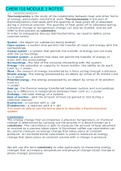
-
CHEM 103 MODULE 3 NOTES
- Class notes • 27 pages • 2022
-
- $14.49
- + learn more
CHEM 103 MODULE 3 NOTES. 3.1: THERMOCHEMISTRY Thermodynamics is the study of the relationship between heat and other forms of energy, particularly mechanical work. Thermochemistry is the part of thermodynamics that deals with the quantity of heat given off or absorbed during a chemical reaction. The quantity of heat given off or absorbed during a physical change or temperature change can also be studied, and we will refer to this process as calorimetry. In order to adequately discuss thermoch...
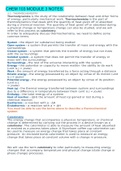
-
CHEM 103 MODULE 3 NOTES.
- Exam (elaborations) • 27 pages • 2022
-
- $15.49
- + learn more
CHEM 103 MODULE 3 NOTES. 3.1: THERMOCHEMISTRY Thermodynamics is the study of the relationship between heat and other forms of energy, particularly mechanical work. Thermochemistry is the part of thermodynamics that deals with the quantity of heat given off or absorbed during a chemical reaction. The quantity of heat given off or absorbed during a physical change or temperature change can also be studied, and we will refer to this process as calorimetry. In order to adequately discuss thermoch...
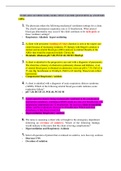
-
CHEM 103 MODULE 3 NOTES.
- Exam (elaborations) • 29 pages • 2022
-
- $14.49
- + learn more
CHEM 103 MODULE 3 NOTES. 3.1: THERMOCHEMISTRY Thermodynamics is the study of the relationship between heat and other forms of energy, particularly mechanical work. Thermochemistry is the part of thermodynamics that deals with the quantity of heat given off or absorbed during a chemical reaction. The quantity of heat given off or absorbed during a physical change or temperature change can also be studied, and we will refer to this process as calorimetry. In order to adequately discuss thermoch...
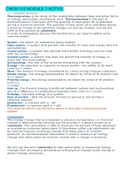
-
CHEM 103 MODULE 3 NOTES.
- Exam (elaborations) • 27 pages • 2022
-
- $15.49
- + learn more
CHEM 103 MODULE 3 NOTES. 3.1: THERMOCHEMISTRY Thermodynamics is the study of the relationship between heat and other forms of energy, particularly mechanical work. Thermochemistry is the part of thermodynamics that deals with the quantity of heat given off or absorbed during a chemical reaction. The quantity of heat given off or absorbed during a physical change or temperature change can also be studied, and we will refer to this process as calorimetry. In order to adequately discuss thermoch...
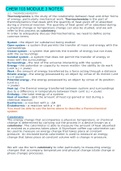
-
CHEM 103 MODULE 3 NOTES
- Class notes • 27 pages • 2022
-
- $14.49
- + learn more
CHEM 103 MODULE 3 NOTES. 3.1: THERMOCHEMISTRY Thermodynamics is the study of the relationship between heat and other forms of energy, particularly mechanical work. Thermochemistry is the part of thermodynamics that deals with the quantity of heat given off or absorbed during a chemical reaction. The quantity of heat given off or absorbed during a physical change or temperature change can also be studied, and we will refer to this process as calorimetry. In order to adequately discuss thermoch...
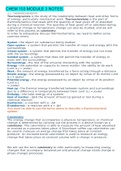
-
CHEM 103 MODULE 3 NOTES.
- Exam (elaborations) • 27 pages • 2022
-
- $15.49
- + learn more
CHEM 103 MODULE 3 NOTES. 3.1: THERMOCHEMISTRY Thermodynamics is the study of the relationship between heat and other forms of energy, particularly mechanical work. Thermochemistry is the part of thermodynamics that deals with the quantity of heat given off or absorbed during a chemical reaction. The quantity of heat given off or absorbed during a physical change or temperature change can also be studied, and we will refer to this process as calorimetry. In order to adequately discuss thermoch...

-
CHEM 103
- Exam (elaborations) • 27 pages • 2022
-
- $14.49
- + learn more
CHEM 103 MODULE 3 NOTES. 3.1: THERMOCHEMISTRY Thermodynamics is the study of the relationship between heat and other forms of energy, particularly mechanical work. Thermochemistry is the part of thermodynamics that deals with the quantity of heat given off or absorbed during a chemical reaction. The quantity of heat given off or absorbed during a physical change or temperature change can also be studied, and we will refer to this process as calorimetry. In order to adequately discuss thermoch...
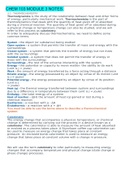
-
CHEM 103 MODULE 3 NOTES.
- Exam (elaborations) • 27 pages • 2021
-
- $16.09
- + learn more
CHEM 103 MODULE 3 NOTES. 3.1: THERMOCHEMISTRY Thermodynamics is the study of the relationship between heat and other forms of energy, particularly mechanical work. Thermochemistry is the part of thermodynamics that deals with the quantity of heat given off or absorbed during a chemical reaction. The quantity of heat given off or absorbed during a physical change or temperature change can also be studied, and we will refer to this process as calorimetry. In order to adequately discuss thermoch...
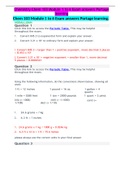
-
Exam (elaborations) Chemistry Chem 103 Module 1 to 6 Exam answers (CHEM103)
- Exam (elaborations) • 37 pages • 2022
-
- $12.34
- + learn more
Exam (elaborations) Chemistry Chem 103 Module 1 to 6 Exam answers (CHEM103) MODULE 1 EXAM Question 1 Click this link to access the Periodic Table. This may be helpful throughout the exam. 1. Convert 845.3 to exponential form and explain your answer. 2. Convert 3.21 x 10-5 to ordinary form and explain your answer. 1. Convert 845.3 = larger than 1 = positive exponent, move decimal 2 places = 8.453 x 102 2. Convert 3.21 x 10-5 = negative exponent = smaller than 1, move decimal 5 place...

That summary you just bought made someone very happy. Also get paid weekly? Sell your study resources on Stuvia! Discover all about earning on Stuvia


